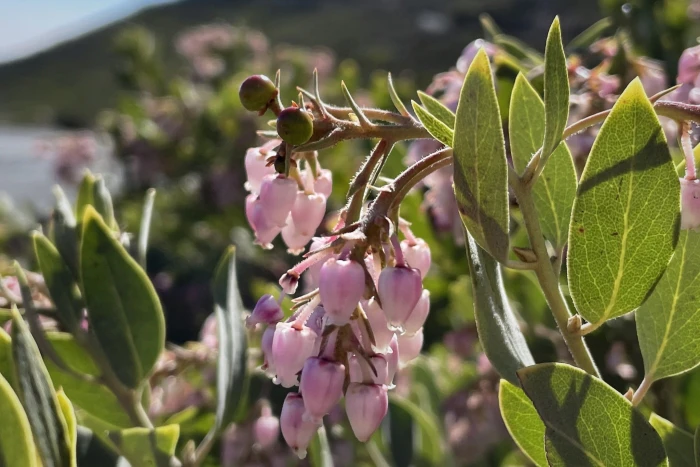Otay Manzanita
(Arctostaphylos otayensis)
Otay Manzanita (Arctostaphylos otayensis)
/
/

Madeleine Claire
CC BY 4.0
Image By:
Madeleine Claire
Recorded By:
Copyright:
CC BY 4.0
Copyright Notice:
Photo by: Madeleine Claire | License Type: CC BY 4.0 | License URL: http://creativecommons.org/licenses/by/4.0/ | Rights Holder: Madeleine Claire | Publisher: iNaturalist | Date Created: 2021-02-06T21:23:56Z |













Estimated Native Range
Climate Requirements for Merrillville, Indiana
| This Plant | Your Site | Plant Suitability for Your Location | ||
|---|---|---|---|---|
| • Precipitation | 11" - 21" | 38" | Aquatic | Aquatic |
| • High Temp. | 85°F - 91°F | 85°F | OK, but your summers are milder than normal for this plant | OK |
| • Low Temp. | 34°F - 45°F | 14°F | Your winter temperatures may be too cold for this plant | Too cold |
This plant may not grow well at your location - your precipitation is too high.
Summary
Arctostaphylos otayensis, commonly known as Otay Manzanita, is an evergreen shrub native to the chaparral ecosystems of the coastal ranges of Southern California and Baja California, Mexico. This species is adapted to dry, rocky slopes and is often found in association with other chaparral species. It typically reaches up to 2.5 meters in height and is noted for its erect form. The bark is distinctive, starting as shreddy red and becoming gray as it ages. Otay Manzanita has smooth, oval-shaped, pointed leaves that are a deep green color. The dense inflorescences of flowers appear in late winter to early spring, with tightly bunched pale pink blooms that are highlighted with bright magenta, offering a striking contrast against the foliage. The fruit is a red drupe, measuring between one half and one centimeter wide, which can attract birds and other wildlife.
Otay Manzanita is valued for its drought tolerance, making it suitable for xeriscaping and native plant gardens. It is also appreciated for its ornamental bark and showy flowers, which can add color to the landscape in the typically bloom-sparse winter months. In cultivation, it thrives in full sun or part shade, requiring very low to low amounts of water, and prefers soils with fast drainage. While it is not commonly used in urban planting due to its specific habitat requirements, it can be an excellent choice for naturalistic and conservation-oriented landscapes. Gardeners should be aware that this plant can be susceptible to root rot if overwatered or planted in poorly drained soils. It is also prone to fungal diseases such as powdery mildew if conditions are too humid or if there is insufficient air circulation.CC BY-SA 4.0
Otay Manzanita is valued for its drought tolerance, making it suitable for xeriscaping and native plant gardens. It is also appreciated for its ornamental bark and showy flowers, which can add color to the landscape in the typically bloom-sparse winter months. In cultivation, it thrives in full sun or part shade, requiring very low to low amounts of water, and prefers soils with fast drainage. While it is not commonly used in urban planting due to its specific habitat requirements, it can be an excellent choice for naturalistic and conservation-oriented landscapes. Gardeners should be aware that this plant can be susceptible to root rot if overwatered or planted in poorly drained soils. It is also prone to fungal diseases such as powdery mildew if conditions are too humid or if there is insufficient air circulation.CC BY-SA 4.0
Plant Description
- Plant Type: Shrub
- Height: 5-15 feet
- Width: 5-10 feet
- Growth Rate: Moderate
- Flower Color: White
- Flowering Season: Spring, Winter
- Leaf Retention: Evergreen
Growth Requirements
- Sun: Full Sun, Part Shade
- Water: Very Low, Low
- Drainage: Fast
Common Uses
Bee Garden, Bird Garden, Butterfly Garden, Deer Resistant, Drought Tolerant, Hummingbird Garden, Low Maintenance
Natural Habitat
Native to the chaparral ecosystems of the coastal ranges of Southern California and Baja California, Mexico
Other Names
Common Names:
Scientific Names: Arctostaphylos otayensis
GBIF Accepted Name: Arctostaphylos otayensis Wiesl. & Schreib.